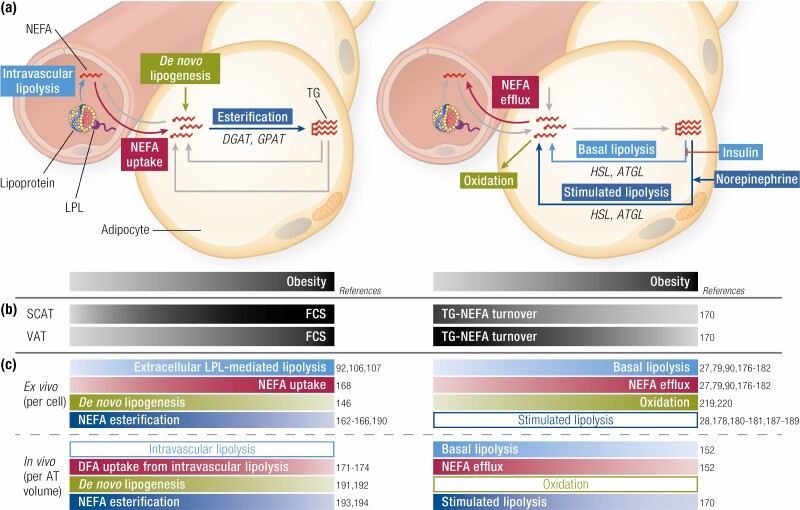Figure 7.
Adipocyte size and lipid metabolism. (A) Left panel: mechanisms leading to adipocyte triglyceride (TG) accumulation include nonesterified fatty acids (NEFAs) uptake from the circulatory pool or from lipoprotein lipase (LPL)-mediated hydrolysis of TG-rich lipoproteins, and de novo synthesis of fatty acids from carbohydrates (de novo lipogenesis). Right panel: mechanisms leading to adipocyte TG mobilization include basal and norepinephrine-stimulated intracellular TG lipolysis leading to NEFA efflux into the circulation or NEFA oxidation. (B) Change in fat cell size in relation to obesity is depicted for abdominal subcutaneous adipose tissue (SCAT) vs visceral adipocyte tissue (VAT) along with change in triglyceride-nonesterified fatty acid (TG-NEFA) turnover based on in vivo studies. (C) Change in the mechanisms leading to adipocyte TG accumulation (left panels) or mobilization (right panels) according to the degree of obesity and fat cell size (FCS) measured ex vivo (upper panels) or in vivo (lower panels). Changes are expressed by the color tone, light tones for low metabolic rates or smaller levels and dark tones for high metabolic rates or higher levels. Empty bands indicate conflicting results or insufficient data to indicate increase or decrease with obesity or fat cell size change. ACS, acetyl-CoA synthetase; ATGL, adipose triglyceride lipase; DGAT, diglyceride acyltransferase; DFA, dietary fatty acid; GPAT, glycerol-3-phosphate acyltransferase; HDL-c, high-density lipoprotein cholesterol; HSL, hormone sensitive lipase; LDL-c, low-density lipoprotein-cholesterol.

